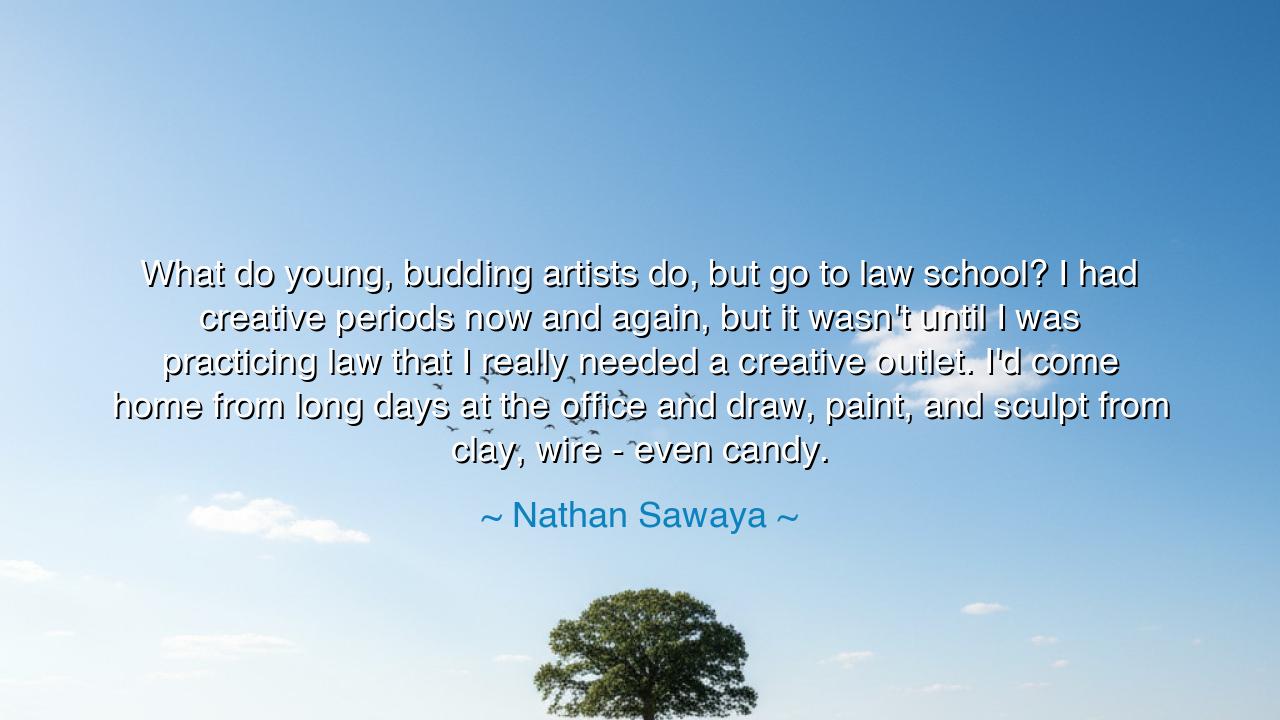
What do young, budding artists do, but go to law school? I had
What do young, budding artists do, but go to law school? I had creative periods now and again, but it wasn't until I was practicing law that I really needed a creative outlet. I'd come home from long days at the office and draw, paint, and sculpt from clay, wire - even candy.






“What do young, budding artists do, but go to law school? I had creative periods now and again, but it wasn't until I was practicing law that I really needed a creative outlet. I'd come home from long days at the office and draw, paint, and sculpt from clay, wire — even candy.” Thus spoke Nathan Sawaya, the sculptor who left the marble pillars of the courtroom to build worlds of color and imagination out of the humblest of materials — the LEGO brick. His words, though laced with humor, conceal a profound truth about the human spirit: that creativity, when denied its freedom, will always find a way to break through the stone walls of convention. It may sleep for a time beneath duty and practicality, but it cannot die. It will whisper in the silence, waiting for the moment when the weary heart, longing for meaning, reaches once again for art.
In his jest — “What do young, budding artists do, but go to law school?” — Sawaya speaks for a generation of dreamers who, pressured by fear or expectation, turn from their passions toward safer shores. The world, ancient and modern alike, has always praised the secure path: the scholar, the statesman, the laborer who builds stability. Yet the artist, the visionary, the poet — these are often told to quiet their gifts, to trade inspiration for certainty. Sawaya’s remark is both irony and lament — for what does it profit the soul to master logic and lose wonder? And yet, even as he buried his art beneath the weight of law, he discovered what every true creator learns: that creation is not a choice, but a need.
When he says, “I really needed a creative outlet,” he is describing the call of the muse — that sacred force which dwells within all who are made to create. The ancients called it daemon, the divine companion who stirs the soul toward expression. For some, it is music; for others, color, stone, or words. In Sawaya’s case, after long days amid the rigid codes of justice, his spirit cried out for play, for freedom, for something that could not be bound by precedent or statute. Thus, he came home not to rest, but to make — shaping not arguments, but form; not verdicts, but visions. His art became not rebellion, but healing — a return to balance between mind and heart.
The story of Nathan Sawaya mirrors that of Michelangelo, who, when asked how he carved the David, replied, “I saw the angel in the marble and carved until I set him free.” Both men were bound — one by marble, one by modernity — yet both heard the same eternal calling: to liberate beauty from confinement. Michelangelo chipped away at stone; Sawaya assembled pieces of color; both were acts of defiance against the dullness of order. For in every age, the artist must carve light from the shadow of structure. Sawaya’s tools — clay, wire, even candy — remind us that art does not demand grandeur. It demands only honesty, the courage to take what lies at hand and give it shape.
And so we see that his quote is not merely about art, but about balance. Life, in its pursuit of success and stability, often drives us into imbalance — too much duty, not enough joy; too much order, not enough wonder. Sawaya’s journey teaches that the intellect alone cannot satisfy the soul. The lawyer in him sought justice; the artist sought truth. Both pursuits are noble, yet one without the other leads to dryness. It was only when he allowed both to exist — when he gave his creative fire space to breathe — that his spirit found peace. This is the lesson the ancients would call harmonia: the sacred equilibrium between the rational and the passionate, between the law of man and the law of the heart.
Even his choice of materials — candy, wire, and clay — holds a message. They are humble, transient things, yet in his hands they became vessels of beauty. In this, Sawaya joins the lineage of creators who transform the ordinary into the divine. Like the potter shaping earth into vessel, or the monk illuminating manuscripts with gold, he shows us that creativity does not demand the perfect tool — only the willingness to begin. His art, born from exhaustion, became not a pastime but a lifeline — proof that joy can rise even from the ashes of routine.
So, my children, hear this truth: within each of you burns a creative spark, however deeply buried. The world may press you into roles of logic and labor, but the soul must create, or it withers. When the day grows long and the spirit grows weary, follow Sawaya’s example — go home, and make something. Sculpt, sing, write, or build, not for applause, but to remind yourself that you are more than a worker; you are a creator. The ancients said that to make is to touch eternity. So do not neglect the artist within you, however small or quiet they seem. For when you give your imagination room to breathe, you too will find — as Nathan Sawaya did — that even after the hardest of days, art can make you feel at home in your own soul once more.






AAdministratorAdministrator
Welcome, honored guests. Please leave a comment, we will respond soon